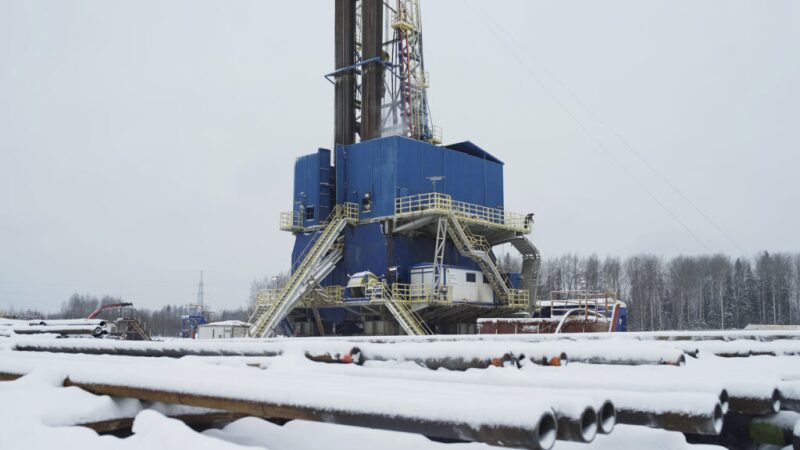As an arctic air mass swept down the great plains and into the breadbasket of US oil production this week, at least 2 million B/D of crude output has been shut in, according to a report from Bloomberg citing company executives and analysts.
A separate report issued by the US Department of Energy (DOE) on Tuesday estimated that natural gas production in Texas is down 30% to 15.7 Bcf/D. The figure represents a 7% drop in total US natural gas production.
The DOE report said the "freeze-offs" that have temporally halted gas output could keep many wells on ice for a few more days. US production averaged 11 million B/D last month and was on track to average about 98 Bcf/D for the first quarter, according to the US Energy Information Administration.
Oil production has been reported to be most impacted in the Permian Basin that spans Texas and New Mexico where temperatures fell to -2° F (-19° C) on Monday. Output was down elsewhere in Texas and Oklahoma as freezing weather caused issues at the wellhead and with other field activities.
West Texas Intermediate (WTI) crude oil was up nearly 1% to $60.05 in Tuesday's trading session. Monday and Tuesday mark the first two days that WTI has breached the $60-mark in a year.
The bigger price jump, though, was seen in the Henry Hub rate which was up almost 7% to $3.10/MMBtu by the end of the session. Meanwhile, spot prices for some regional sources of natural gas have seen once-in-a-generation spikes due to the artic blast.
This was especially true in Oklahoma where gas that cost around 3$/MMBtu at the start of the month had by Tuesday morning hit the state’s maximum allowable rate of $999/MMBtu. By comparison, in neighboring Texas, spot gas prices were a mere $100/MMBtu.
US markets were driving gas prices higher in general as more than 4.4 million homes and businesses across Texas were out of power during the peak of a major winter storm that brought temperatures to their lowest point in more than 30 years. The figure, which comes from the state’s power outage website, represents more than a third of electric customers in Texas.
The winter storm is impacting much of the southern and central US, but warm-natured Texas has been especially caught off guard as its chief sources of electricity generation proved ill-equipped for the big chill.
First, about half of the wind power generation capacity in Texas was lost as turbines in the western and northern part of the state froze up on Sunday. During peak periods, wind turbines supply about 20% of the state’s electricity.
This first domino fell while Texas energy consumers set a new state record of 69,150 megawatts of demand. It is possible a new record could be set later in the week as millions of Texans seek to thaw out, the DOE said in its report.
The next major shortfall in supply came overnight and into Monday morning when sub-freezing temperatures along with ice and snow drove about 40% of the state’s electric capacity from natural gas-burning power plants offline.
The natural gas plants shut down due to a result of frozen instruments and issues with sourcing supply, this according to a Bloomberg report citing Texas’ power grid operator, the Electric Reliability Council of Texas (ERCOT).
ERCOT also said the loss of natural gas generating capacity, combined with that lost from iced-over coal and nuclear plants, was the largest driver for the widespread blackouts.
The rare weather event has led to other ripple effects down the supply chain that are further hampering efforts to restore power. ERCOT said pressures in natural gas lines that feed the power plants are below normal levels as pipeline and field issues pop up across Texas.
Natural gas pipeline facilities and gas wellheads suffer from freeze-offs when the water and other liquids in the production stream freeze. The oil fields in Texas and New Mexico are also not winterized, as they are in North Dakota or Alberta, which leaves them vulnerable to freeze-offs too.
Outside of production, energy consultancy Rystad Energy said that the cold weather in west Texas was impacting hydraulic fracturing and flowback operations more than it was drilling. Noting the reports of major volumes of Permian oil being shut in, Rystad expects it will take some time for US supply to bounce back above 9 million B/D.
However, the consultancy added that WTI’s $60 rally was likely an overreaction to news of the cold snap and that any supply shortages would be offset be the refinery outages.
More than 3 million B/D of downstream capacity was lost by Tuesday as many of the state’s largest refineries began shutting down as freezing temperatures threatened their treating units.
The list includes ExxonMobil’s 369,000 B/D facility in Beaumont and its 560,000 B/D refinery and chemical plant in Baytown. Citgo, Marathon, LyondellBasell, also shut down facilities with a combined output of over 1 million B/D.
Check JPT's follow-up coverage of the storm:



